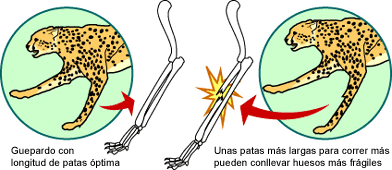Hay muchas razones por las que la selección natural no puede producir un carácter «perfectamente diseñado». Por ejemplo, podría imaginarse que los guepardos serían más aptos (producirían más descendencia) si pudieran correr sólo un poquito más rápido y atrapar más presas. He aquí varias razones por las cuales la selección natural no podría producir la perfección, o guepardos más rápidos:
- Falta de la variabilidad genética necesaria
La selección sólo puede actuar sobre la variabilidad genética disponible. Un guepardo podría correr más rápido si tuviera «genes para correr más rápido»; pero si en la población no hay genes «más rápido» debido a las mutaciones o al flujo génico, no habrá evolución en este sentido. Un guepardo «más rápido» podría evolucionar si el guepardo más rápido de esta población transmitiera sus genes «más rápido» a su descendencia.
- Restricciones debidas a la historia
A lo mejor una disposición diferente de los músculos y huesos de las patas daría lugar a guepardos que corrieran más rápido, pero la forma corporal básica de los mamíferos está dispuesta en sus genes y en su desarrollo de una manera tan mutuamente restrictiva que es muy poco probable que sea alterada. Realmente es posible que «no se pueda ir hasta allí desde aquí». - Compensaciones
Mejorar un rasgo podría empeorar otro. Quizás haya «genes más rápido» en la población, pero haya un compromiso asociado con ellos: correr más rápido durante distancias cortas significa que el metabolismo del guepardo requiere todavía más energía o que sus patas deben volverse peligrosamente delicadas. Aunque unos huesos de las extremidades más largos alargan la zancada, simultáneamente aumenta la probabilidad de que fallen cuando se someten a cargas de flexión. Por lo tanto, en este caso quizás no lograría un aumento neto de la eficacia biológica como resultado de los «genes para correr más rápido».
Learn more about evolutionary baggage and constraints in context:
- Mantis shrimp shoulder their evolutionary baggage and bluff, a case study.
- Oxygen as an evolutionary constraint, a news brief with discussion questions.
Learn more about evolutionary trade-offs in context:
- Evolution from a virus's view, a news brief with discussion questions.
- Quick evolution leads to quiet crickets, a news brief with discussion questions.
Teach your students about evolutionary baggage and constraints: Interactive investigation: The arthropod story, a web activity for grades 6-12.
Find additional lessons, activities, videos, and articles that focus on evolutionary baggage and constraints.
Original translation by the Spanish Society of Evolutionary Biology; translation editing by Maya deVries


